自闭症谱系障碍儿童的团体游戏治疗(2015-10-17)
- 格式:pptx
- 大小:425.19 KB
- 文档页数:52
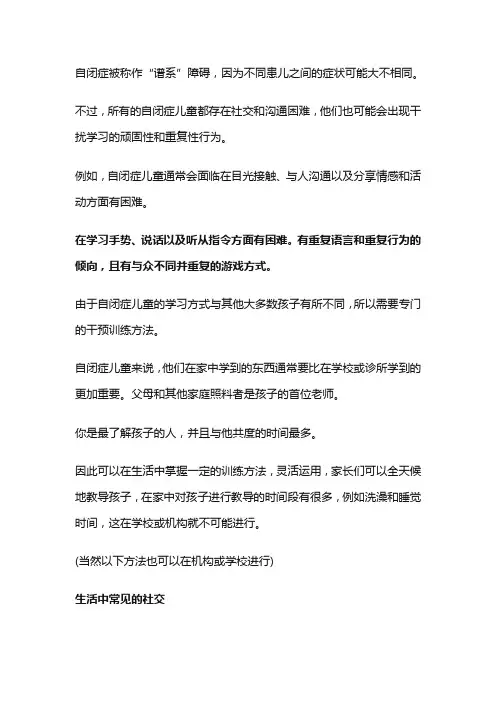
自闭症被称作“谱系”障碍,因为不同患儿之间的症状可能大不相同。
不过,所有的自闭症儿童都存在社交和沟通困难,他们也可能会出现干扰学习的顽固性和重复性行为。
例如,自闭症儿童通常会面临在目光接触、与人沟通以及分享情感和活动方面有困难。
在学习手势、说话以及听从指令方面有困难。
有重复语言和重复行为的倾向,且有与众不同并重复的游戏方式。
由于自闭症儿童的学习方式与其他大多数孩子有所不同,所以需要专门的干预训练方法。
自闭症儿童来说,他们在家中学到的东西通常要比在学校或诊所学到的更加重要。
父母和其他家庭照料者是孩子的首位老师。
你是最了解孩子的人,并且与他共度的时间最多。
因此可以在生活中掌握一定的训练方法,灵活运用,家长们可以全天候地教导孩子,在家中对孩子进行教导的时间段有很多,例如洗澡和睡觉时间,这在学校或机构就不可能进行。
(当然以下方法也可以在机构或学校进行)生活中常见的社交购物训练目标:让孩子学会购物,购物是日常生活中经常发生的事情,是典型的实用性交往,从小锻炼孩子,让他们学会生活中的一般性购物。
训练步骤▼1、经常带孩子购物,在这个过程中给孩子讲解每个细节。
2、让孩子完成购物中的一个环节。
3、让孩子体验购物的快乐和自己在购物中的重要作用,理解购物意义感受成功。
4、一个环节巩固后,在向前一步骤或者或者后一步骤进行,完成更多的购物环节。
5、让孩子独立购物。
提示和解析▼1、生活中的日常物品购买这类活动,都可以作为孩子的学习内容。
2、购物的时间,场所,内容等因素,可以构成有易到难的阶段,让孩子从最简单的学起。
3、将购物活动分解为若干步骤,找最容易的环节突破,逐渐加大难度。
让孩子理解购物的意义,要使购物成为孩子的生活必须行为,为孩子成就感。
4、购物程序的语言表达很重要,不可以忽略。
购物完成以后,给孩子总结同类交往的一般规则,以便让孩子迁移。
卫生间在哪里训练目标:让孩子学会通过交往,询问需要的信息。
训练过程▼1、告诉孩子需要解决的问题是什么,告诉孩子怎样才可以解决问题。
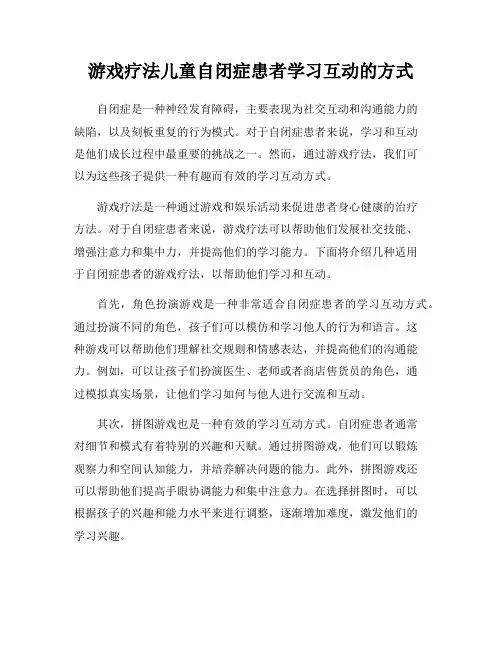
游戏疗法儿童自闭症患者学习互动的方式自闭症是一种神经发育障碍,主要表现为社交互动和沟通能力的缺陷,以及刻板重复的行为模式。
对于自闭症患者来说,学习和互动是他们成长过程中最重要的挑战之一。
然而,通过游戏疗法,我们可以为这些孩子提供一种有趣而有效的学习互动方式。
游戏疗法是一种通过游戏和娱乐活动来促进患者身心健康的治疗方法。
对于自闭症患者来说,游戏疗法可以帮助他们发展社交技能、增强注意力和集中力,并提高他们的学习能力。
下面将介绍几种适用于自闭症患者的游戏疗法,以帮助他们学习和互动。
首先,角色扮演游戏是一种非常适合自闭症患者的学习互动方式。
通过扮演不同的角色,孩子们可以模仿和学习他人的行为和语言。
这种游戏可以帮助他们理解社交规则和情感表达,并提高他们的沟通能力。
例如,可以让孩子们扮演医生、老师或者商店售货员的角色,通过模拟真实场景,让他们学习如何与他人进行交流和互动。
其次,拼图游戏也是一种有效的学习互动方式。
自闭症患者通常对细节和模式有着特别的兴趣和天赋。
通过拼图游戏,他们可以锻炼观察力和空间认知能力,并培养解决问题的能力。
此外,拼图游戏还可以帮助他们提高手眼协调能力和集中注意力。
在选择拼图时,可以根据孩子的兴趣和能力水平来进行调整,逐渐增加难度,激发他们的学习兴趣。
另外,音乐游戏也是一种非常适合自闭症患者的学习互动方式。
音乐可以激发孩子们的情感和创造力,帮助他们表达自己的情感和思维。
通过音乐游戏,他们可以学习节奏、音调和音乐表达方式,提高他们的音乐感知和表达能力。
此外,音乐还可以帮助他们放松身心,减轻焦虑和压力。
可以让孩子们尝试弹奏乐器、唱歌或者参加音乐合唱团等活动,让他们在音乐中找到乐趣和自信。
最后,电子游戏也可以作为一种学习互动的方式,帮助自闭症患者提高学习能力和社交技能。
一些特别设计的教育电子游戏可以帮助他们学习字母、数字、颜色等基础知识,并通过游戏的互动性激发他们的学习兴趣。
此外,一些多人在线游戏也可以帮助他们与他人进行社交互动,提高他们的社交能力和合作精神。
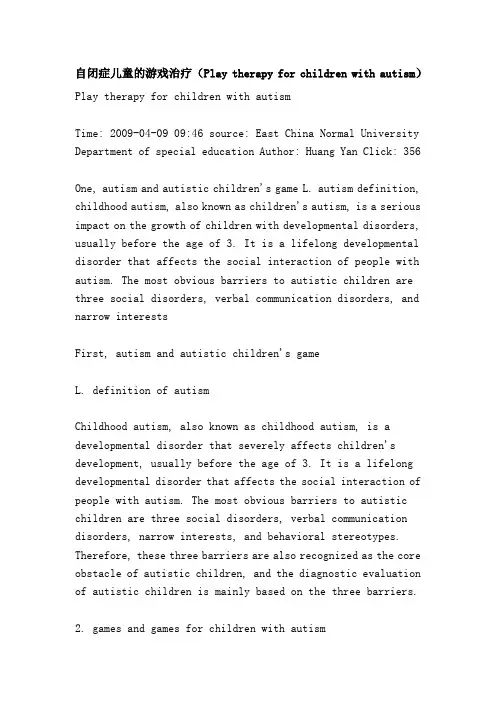
自闭症儿童的游戏治疗(Play therapy for children with autism)Play therapy for children with autismTime: 2009-04-09 09:46 source: East China Normal University Department of special education Author: Huang Yan Click: 356One, autism and autistic children's game L. autism definition, childhood autism, also known as children's autism, is a serious impact on the growth of children with developmental disorders, usually before the age of 3. It is a lifelong developmental disorder that affects the social interaction of people with autism. The most obvious barriers to autistic children are three social disorders, verbal communication disorders, and narrow interestsFirst, autism and autistic children's gameL. definition of autismChildhood autism, also known as childhood autism, is a developmental disorder that severely affects children's development, usually before the age of 3. It is a lifelong developmental disorder that affects the social interaction of people with autism. The most obvious barriers to autistic children are three social disorders, verbal communication disorders, narrow interests, and behavioral stereotypes. Therefore, these three barriers are also recognized as the core obstacle of autistic children, and the diagnostic evaluation of autistic children is mainly based on the three barriers.2. games and games for children with autismThe game allows children to learn and practice new skills in a safe and supportive environment, including language skills, activity skills, and social interaction skills. In addition, the game is widely believed to be children's own unique expression way of communication, especially in the expression of some children cannot tell the emotional experience and inner thoughts. The game is enjoyable, so children can enjoy a lot of fun in the game and promote the development of children physically and mentally.The game behavior of children with autism is often limited to simple operation, non autistic children with the same age as compared to lower their quality of the game, and the lack of (spontaneous) * * * or the symbol of impaired ability.In addition, some autistic children also show that they do not want to play with other children, but rather prefer to play by themselves. There are also some autistic children who want to play games with others, but they have great difficulties in expressing that desire, such as lack of language or other communication skills.Two, game therapy for children with autism1. definition and development of game therapySince twentieth Century, pediatric psychologists and clinical psychologists have begun to recognize the therapeutic role of games and have been trying game therapy throughout the course of their clinical treatment. Game therapy is a therapy thattherapists use games as the main communication medium to correct children's psychological and behavioral disorders. In 1982, the International Association for game therapy was established, which marked the approval of game therapy as an independent psychological therapy. After 1990s, game therapy continued to grow and be widely used.From the perspective of history, game therapy has gone through three stages of development: psychoanalytic orientation, game therapy, structuralist game therapy, and humanistic game therapy.In 1920s, A.Freud and M.Klein began to systematically organize how to use games for child psychoanalysis and therapy, and opened game therapy as a prelude to psychotherapy. In psychoanalytic game therapy, therapists emphasize the importance of language. They think that only when the children's language development to a certain extent, can help children from the game, so in the game for children aged 5 years and older in general. But it is particularly important to analysis of the spirit of play therapists thought that the game itself has no treatment, they just put the game as a necessary medium of children's psychological analysis, it is through the game to analyze the content of children's children's subconscious.Later, structured game therapy was developed from psychoanalysis. The game analysis of structured treatment method does not emphasize the subconscious, but according to the specific circumstances of the child therapist, active design games, let the children out of energy and release pentup emotions in a certain structure of the game, in order to solve the psychological problems of children's treatment goal.The next humanistic game therapy was proposed by Rogers. Rogers believes that everyone has a positive drive forward, but in a real social life it is difficult to get the unconditional positive respect of others. Only when individuals are in an environment of unconditional respect can they truly express themselves. Therefore, humanistic play therapy attaches great importance to creating a warm and friendly treatment environment for children. [nextpage]2. theoretical foundations of game therapy for children with autismAlthough researchers have done a lot of work, the exact cause of autism remains unclear.Therefore, researchers have proposed various theoretical hypotheses to explain the causes of autism. Among them, Baron-Cohen, Leslie and the lack of psychological theory hypothesis proposed by Frith, they found in the study, with performance on false belief task in patients with significant difference in patients with Down syndrome and normal children, children with autism show that individuals can not understand themselves and others mental state. Kleinman and other studies show that they can't recognize their mental states by voice, tone, or people's eye photographs. These findings strongly demonstrate the lack of psychological theory in autistic children. Because of the lack of psychological theory, autistic children have difficulty understanding people's intentions andpsychological states when they are communicating with people. Therefore, in the complex, difficult to coordinate the social environment, autistic children can not predict and explain the behavior of others, it is difficult to ignore the complex social interaction rules, and cannot maintain reciprocal behavior in social interaction, such as based on common experiences, thoughts and feelings and to care and trust others need to understand the psychological state of the. This largely explains the barriers to social interaction among autistic children.The lack of psychological theory also explains the game characteristics of autistic children. As mentioned above, autistic children lack spontaneous pretend play and social imitation games during their game development, and their ability to symbolize * * * is very poor. It is possible that autistic children lack the theory of mind and that it is difficult to understand the mental state of other people in real life, and therefore it is difficult to use such skills in games. In turn, autistic children are less able to develop the same ability to understand and imitate the game as other children do because of the lack of symbolism. Therefore, some researchers put forward development through training method for children with autism symbol * * * ability to promote the ability of various aspects, including language, social intercourse, that can be carried out by a symbol of * * * skills training for children with autism, to help them learn and practice to imitate behavior; through the role of the exchange, let play they can learn to stand in the perspective of others, others may experience mental state, help them develop the ability to understand others' expectations and thoughts.Game therapy itself has its advantages. Compared to other training methods, games are more acceptable for children and more conducive to communication between therapists and autistic children with language communication disorders. This makes it easier for game therapy to go into the lives of autistic children and for long periods of time.Three, the practice of game therapy for children with autismAt the level of application practice, some researchers abroad have adopted the game method to treat autistic children.Researchers have summarized the overseas literature in this area, mainly Bromfield (1989) of children with high functioning autism treatment, Lowery (1985) and Lanyado (1987) Nehama, a case study for autistic children with Baum (1986) introduced the family therapy in the treatment of people with autism, as well as Wolfberg and Schuler (1993). The treatment of autistic children in group play therapy, the treatment has some effect.Liu Minna and others suggested that children's center game therapy is more suitable for children who are 3-12 years old and have certain verbal expression and motor function, including autistic children. There are also surveys found that in the family practice of autistic children, parents mainly based on game therapy. In addition, a number of researchers have conducted case studies of game therapy for children with autism. For example, Qiu Xueqing (2001) for a 3 year old children with autism lack of play therapy for more than three months after the treatment, the child's language, action games, socialinteraction and peer development has made significant progress. Kou Yan also studied the case of sandplay therapy for children with autism. The results showed that after the treatment of autistic children's self feeling of energy enhancement; imaginary component of the game is increasing; separate from the game gradually to simple cooperative game development.Although researchers have conducted these studies, but the game is not much systematic research treatment for children with autism, and in the treatment of children with autism, play therapy also did not form a method of independent and mature. Moreover, the study of the traditional game therapy is very difficult because the research of related aspects is almost in the form of case study.Four, summaryAutistic children have unique game features. The lack of symbolic personality reflects not only the lack of the psychological theory of autistic children, but also the imagination and thinking of the researchers on the treatment of children with autism. Game therapy has its unique advantages,It is easy to be accepted by children and is conducive to communication with children. Therefore, there is a certain theoretical basis for game therapy for autistic children. Some researchers use game therapy to train autistic children and get some therapeutic effects. But in general, the study of game therapy for autistic children is not systematic, and researchers have challenged this approach. Therefore, moreempirical studies are needed to investigate the effectiveness and limitations of game therapy for children with autism。
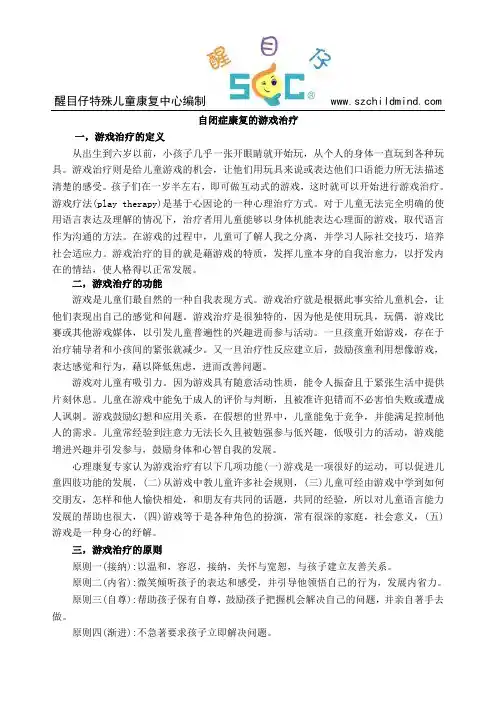
醒目仔特殊儿童康复中心编制自闭症康复的游戏治疗一,游戏治疗的定义从出生到六岁以前,小孩子几乎一张开眼睛就开始玩,从个人的身体一直玩到各种玩具。
游戏治疗则是给儿童游戏的机会,让他们用玩具来说或表达他们口语能力所无法描述清楚的感受。
孩子们在一岁半左右,即可做互动式的游戏,这时就可以开始进行游戏治疗。
游戏疗法(play therapy)是基于心因论的一种心理治疗方式。
对于儿童无法完全明确的使用语言表达及理解的情况下,治疗者用儿童能够以身体机能表达心理面的游戏,取代语言作为沟通的方法。
在游戏的过程中,儿童可了解人我之分离,并学习人际社交技巧,培养社会适应力。
游戏治疗的目的就是藉游戏的特质,发挥儿童本身的自我治愈力,以抒发内在的情结,使人格得以正常发展。
二,游戏治疗的功能游戏是儿童们最自然的一种自我表现方式。
游戏治疗就是根据此事实给儿童机会,让他们表现出自己的感觉和问题。
游戏治疗是很独特的,因为他是使用玩具,玩偶,游戏比赛或其他游戏媒体,以引发儿童普遍性的兴趣进而参与活动。
一旦孩童开始游戏,存在于治疗辅导者和小孩间的紧张就减少。
又一旦治疗性反应建立后,鼓励孩童利用想像游戏,表达感觉和行为,藉以降低焦虑,进而改善问题。
游戏对儿童有吸引力。
因为游戏具有随意活动性质,能令人振奋且于紧张生活中提供片刻休息。
儿童在游戏中能免于成人的评价与判断,且被准许犯错而不必害怕失败或遭成人讽刺。
游戏鼓励幻想和应用关系,在假想的世界中,儿童能免于竞争,并能满足控制他人的需求。
儿童常经验到注意力无法长久且被勉强参与低兴趣,低吸引力的活动,游戏能增进兴趣并引发参与,鼓励身体和心智自我的发展。
心理康复专家认为游戏治疗有以下几项功能(一)游戏是一项很好的运动,可以促进儿童四肢功能的发展,(二)从游戏中教儿童许多社会规则,(三)儿童可经由游戏中学到如何交朋友,怎样和他人愉快相处,和朋友有共同的话题,共同的经验,所以对儿童语言能力发展的帮助也很大,(四)游戏等于是各种角色的扮演,常有很深的家庭,社会意义,(五)游戏是一种身心的纾解。
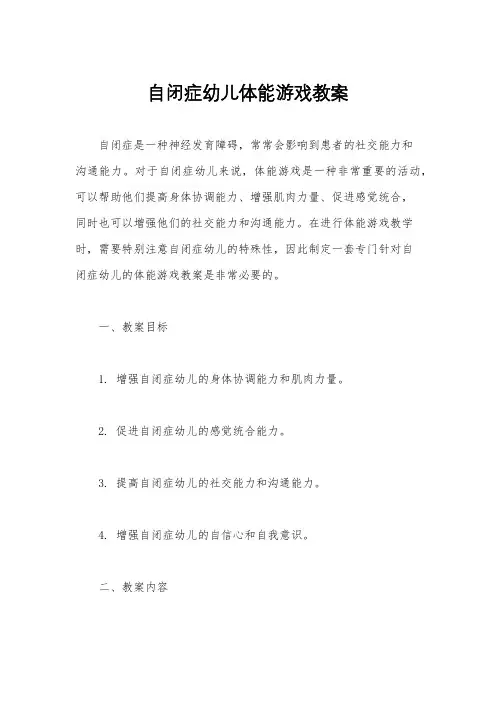
自闭症幼儿体能游戏教案自闭症是一种神经发育障碍,常常会影响到患者的社交能力和沟通能力。
对于自闭症幼儿来说,体能游戏是一种非常重要的活动,可以帮助他们提高身体协调能力、增强肌肉力量、促进感觉统合,同时也可以增强他们的社交能力和沟通能力。
在进行体能游戏教学时,需要特别注意自闭症幼儿的特殊性,因此制定一套专门针对自闭症幼儿的体能游戏教案是非常必要的。
一、教案目标1. 增强自闭症幼儿的身体协调能力和肌肉力量。
2. 促进自闭症幼儿的感觉统合能力。
3. 提高自闭症幼儿的社交能力和沟通能力。
4. 增强自闭症幼儿的自信心和自我意识。
二、教案内容1. 游戏一:传球游戏目标:增强自闭症幼儿的身体协调能力和社交能力。
方法:让自闭症幼儿站成一个圈,每个幼儿手中拿着一个球。
教师示范传球的动作,然后让幼儿们依次传球,传球时可以用简单的口令或动作来引导。
通过这个游戏,可以让自闭症幼儿学会与他人合作,增强他们的社交能力。
2. 游戏二:障碍跑目标:提高自闭症幼儿的身体协调能力和肌肉力量。
方法:在室内或室外设置一些简单的障碍物,如绳子、桶、椅子等,让自闭症幼儿依次跨过这些障碍物。
可以设置一些奖励措施,激励幼儿们积极参与。
通过这个游戏,可以让自闭症幼儿锻炼身体,提高他们的身体协调能力和肌肉力量。
3. 游戏三:感觉统合游戏目标:促进自闭症幼儿的感觉统合能力。
方法:准备一些不同材质和形状的物品,如毛绒玩具、塑料球、纸张等,让自闭症幼儿通过触摸和感受这些物品,同时可以引导他们描述这些物品的特点。
通过这个游戏,可以帮助自闭症幼儿提高感觉统合能力,同时也可以增强他们的观察力和认知能力。
4. 游戏四:音乐游戏目标:提高自闭症幼儿的社交能力和沟通能力。
方法:播放一些简单、欢快的音乐,让自闭症幼儿跟随音乐的节奏做一些简单的舞蹈动作。
可以让他们自由发挥,也可以根据音乐的节奏进行一些指导。
通过这个游戏,可以让自闭症幼儿感受音乐的美妙,同时也可以增强他们的社交能力和沟通能力。
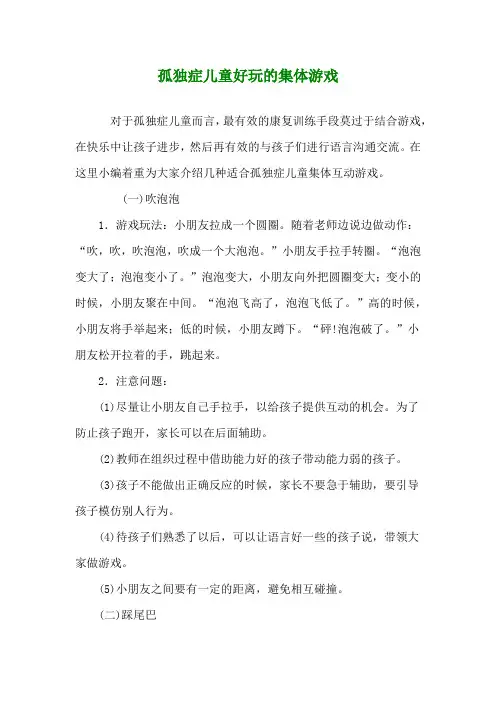
孤独症儿童好玩的集体游戏对于孤独症儿童而言,最有效的康复训练手段莫过于结合游戏,在快乐中让孩子进步,然后再有效的与孩子们进行语言沟通交流。
在这里小编着重为大家介绍几种适合孤独症儿童集体互动游戏。
(一)吹泡泡1.游戏玩法:小朋友拉成一个圆圈。
随着老师边说边做动作:“吹,吹,吹泡泡,吹成一个大泡泡。
”小朋友手拉手转圈。
“泡泡变大了;泡泡变小了。
”泡泡变大,小朋友向外把圆圈变大;变小的时候,小朋友聚在中间。
“泡泡飞高了,泡泡飞低了。
”高的时候,小朋友将手举起来;低的时候,小朋友蹲下。
“砰!泡泡破了。
”小朋友松开拉着的手,跳起来。
2.注意问题:(1)尽量让小朋友自己手拉手,以给孩子提供互动的机会。
为了防止孩子跑开,家长可以在后面辅助。
(2)教师在组织过程中借助能力好的孩子带动能力弱的孩子。
(3)孩子不能做出正确反应的时候,家长不要急于辅助,要引导孩子模仿别人行为。
(4)待孩子们熟悉了以后,可以让语言好一些的孩子说,带领大家做游戏。
(5)小朋友之间要有一定的距离,避免相互碰撞。
(二)踩尾巴1.游戏玩法:准备纸条若干,将纸条的三分之一塞进裤腰里,其余部分拖在外面当尾巴。
两人一组,一个儿童当踩尾巴的人,另一个在场地上跑着躲避,不让对方踩到自己的尾巴。
2.注意问题:(1)孤独症儿童往往会无目的地乱跑,因此家长或教师要注意引导孩子关注对方。
(2)开始时,教师可以将孩子的角色固定下来,待孩子掌握以后再换过来。
对于能力弱的孩子,教师可以安排家长和孩子一组,待熟悉后,再安排小朋友之间的互动;在小朋友互动时,能力稍强的宜扮演“长尾巴的”,能力差异不要过于悬殊。
(3)为发展互动可以适当允许孩子之间的碰撞,家长不要太理会“谁吃亏、谁占便宜”的问题,等待孤独症儿童自己的反应。
(三)两人二足1.游戏玩法:两个小朋友互相搭肩,将两人互靠的一条腿用绳子绑在一起,两人像是长着三条腿,然后再协同一致向前走。
2.注意问题:(1)开始时,教师可以组织家长和孩子组成一组。

幼儿自闭症的社交互动训练游戏自闭症是一种儿童神经发育障碍,主要表现为社交互动和沟通能力的缺陷。
对于幼儿自闭症患者来说,社交互动训练是非常重要的一部分,可以帮助他们改善社交技能、增强沟通能力和提高自信心。
在幼儿自闭症的治疗过程中,游戏是一种非常有效的训练方式。
本文将介绍几种适合幼儿自闭症的社交互动训练游戏。
1. 角色扮演游戏角色扮演游戏是一种能够帮助幼儿自闭症患者模拟真实社交场景的游戏。
在游戏中,可以设定不同的角色和情境,让幼儿扮演其中的一个角色,并与其他角色进行互动。
通过模拟真实社交场景,幼儿可以学习如何与他人进行交流、合作和解决问题。
这种游戏可以培养幼儿的社交技能和情绪管理能力。
2. 团队合作游戏团队合作游戏是一种能够培养幼儿自闭症患者合作能力和团队意识的游戏。
在游戏中,可以组织幼儿参与一些需要团队合作的活动,如搭建积木、完成拼图等。
通过这些活动,幼儿可以学会与他人合作、分工合作和共同解决问题。
这种游戏可以提高幼儿的社交技能和团队意识,培养他们与他人合作的能力。
3. 模仿游戏模仿游戏是一种能够帮助幼儿自闭症患者学习社交技能和语言表达能力的游戏。
在游戏中,可以设定一些动作或语言,让幼儿模仿并与其他人进行互动。
通过模仿游戏,幼儿可以学习如何与他人进行交流、模仿他人的动作和语言,并逐渐提高自己的社交技能和语言表达能力。
4. 感觉游戏感觉游戏是一种能够帮助幼儿自闭症患者感知和理解他人情感的游戏。
在游戏中,可以使用一些感觉器材,如触摸板、声音盒等,让幼儿通过触摸、听觉等感觉方式来感知和理解他人的情感。
通过感觉游戏,幼儿可以学习如何感知和理解他人的情感,并逐渐提高自己的情感理解能力。
5. 社交互动电子游戏社交互动电子游戏是一种能够帮助幼儿自闭症患者提高社交技能和沟通能力的游戏。
在游戏中,可以使用一些专门设计的社交互动电子游戏,如虚拟社交场景、角色扮演游戏等。
通过这些游戏,幼儿可以在虚拟环境中进行社交互动,学习如何与他人进行交流、合作和解决问题。
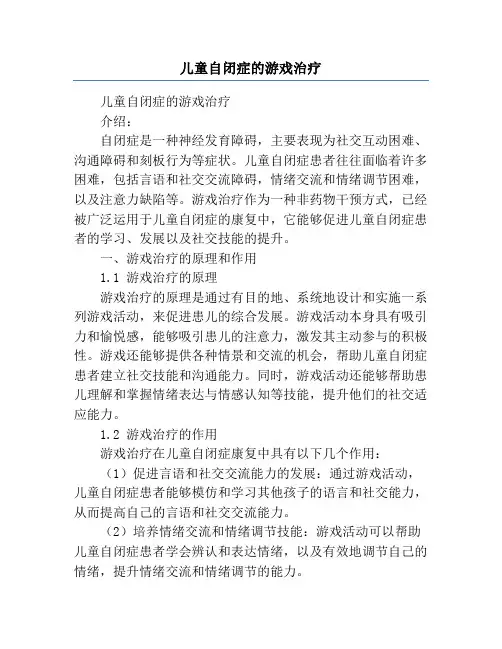
儿童自闭症的游戏治疗儿童自闭症的游戏治疗介绍:自闭症是一种神经发育障碍,主要表现为社交互动困难、沟通障碍和刻板行为等症状。
儿童自闭症患者往往面临着许多困难,包括言语和社交交流障碍,情绪交流和情绪调节困难,以及注意力缺陷等。
游戏治疗作为一种非药物干预方式,已经被广泛运用于儿童自闭症的康复中,它能够促进儿童自闭症患者的学习、发展以及社交技能的提升。
一、游戏治疗的原理和作用1.1 游戏治疗的原理游戏治疗的原理是通过有目的地、系统地设计和实施一系列游戏活动,来促进患儿的综合发展。
游戏活动本身具有吸引力和愉悦感,能够吸引患儿的注意力,激发其主动参与的积极性。
游戏还能够提供各种情景和交流的机会,帮助儿童自闭症患者建立社交技能和沟通能力。
同时,游戏活动还能够帮助患儿理解和掌握情绪表达与情感认知等技能,提升他们的社交适应能力。
1.2 游戏治疗的作用游戏治疗在儿童自闭症康复中具有以下几个作用:(1)促进言语和社交交流能力的发展:通过游戏活动,儿童自闭症患者能够模仿和学习其他孩子的语言和社交能力,从而提高自己的言语和社交交流能力。
(2)培养情绪交流和情绪调节技能:游戏活动可以帮助儿童自闭症患者学会辨认和表达情绪,以及有效地调节自己的情绪,提升情绪交流和情绪调节的能力。
(3)提高社交适应能力:通过各种社交游戏活动,儿童自闭症患者能够更好地理解社交规则和习惯,增加社交技能和适应能力,从而更好地融入社会生活。
二、常见的游戏治疗方法2.1 社交化游戏社交化游戏是指那些需要两个或多个人参与的游戏,例如角色扮演、合作游戏和团队游戏等。
这些游戏活动能够让患儿学会分享、合作、理解和解释他人的情绪,并提高他们的社交技能和情绪认知能力。
2.2 视觉游戏视觉游戏是利用图画、图片和视觉材料进行的游戏活动。
这些游戏可以训练儿童自闭症患者的观察力、注意力和记忆力,提高他们的工作记忆和解决问题的能力。
2.3 手眼协调游戏手眼协调游戏主要包括搭积木、拼图和手工制作等活动。

1、两眼闭合双臂伸直单脚站立5秒;训练目的:身体的协调和平衡能力。
训练要求:孩子闭着眼睛,单脚站立5秒钟。
难度设置:开始时先练习双手伸展或垂直地站立帮助给予:1如果孩子无法自觉地闭上眼睛,可尝试用布蒙上他/她的眼睛。
如果孩子不愿意,先让他/她尝试习惯不练习的时候蒙上眼睛的感觉;2 充分运用奖励的原则来激发孩子的合作性;3任何时候都要准备好给予适当的身体协助。
2、平衡与协调;训练目的:平衡、协调、肌力等。
训练要求:仰卧/俯卧。
难度设置:(1)仰卧双脚着地,双腿屈伸;(2)俯卧双脚着地,双腿屈伸;(3)俯卧双手着地,双腿屈伸;(4)仰卧双手着地,双腿屈伸;(5)仰卧/俯卧双手做模仿或规定动作; (6)仰卧/俯卧双脚做模仿或规定动作;(7)仰卧垫上,双脚屈腿或直腿将球夹起。
帮助给予:(1)每一动作次数或时间不能太久(视其肌张力而定);(2)动作由易而难、次数时间由少到多;(3)注意协助(他动─协动─主动)。
全程由家长身体指导完成。
如果孩子出现紧张或抗拒的情况,请以鼓励、引导方式取得其配合为主,不要强迫配合,以免造成孩子肌肉过度紧张,效果适得其反。
3、跳数字训练目的:增强身体平衡能力及重力感。
训练要求:用不粘胶剪出大的数目字1-10或1-20贴到圆形的不粘胶上再地板上,让孩子从一个数字跨到另外一个数字上,以跨到圆形内为胜。
难度设置:A 如果孩子还不懂得数字,可贴不同颜色的数字,然后让孩子按颜色跳;B 让孩子按指定的数字跳或者按单、双数跳;C 可玩双人游戏,创造出各种玩法,以最终达到终点为胜。
帮助给予:1 如果孩子跳跃技巧不成熟,可在开始时握他(她)的双手或夹着孩子的腋下帮助他(她)跳跃;2 如果孩子不懂得或不遵守游戏规则,要随时给予身体或口头的提示。
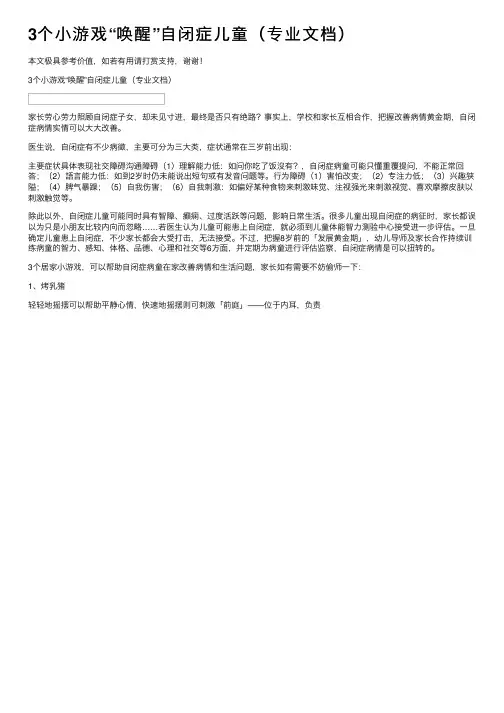
3个⼩游戏“唤醒”⾃闭症⼉童(专业⽂档)
本⽂极具参考价值,如若有⽤请打赏⽀持,谢谢!
3个⼩游戏“唤醒”⾃闭症⼉童(专业⽂档)
家长劳⼼劳⼒照顾⾃闭症⼦⼥,却未见⼨进,最终是否只有绝路?事实上,学校和家长互相合作,把握改善病情黄⾦期,⾃闭症病情实情可以⼤⼤改善。
医⽣说,⾃闭症有不少病徵,主要可分为三⼤类,症状通常在三岁前出现:
主要症状具体表现社交障碍沟通障碍(1)理解能⼒低:如问你吃了饭沒有?,⾃闭症病童可能只懂重覆提问,不能正常回答;(2)語⾔能⼒低:如到2岁时仍未能说出短句或有发⾳问题等。
⾏为障碍(1)害怕改变;(2)专注⼒低;(3)兴趣狭隘;(4)脾⽓暴躁;(5)⾃我伤害;(6)⾃我刺激:如偏好某种⾷物来刺激味觉、注视强光来刺激视觉、喜欢摩擦⽪肤以刺激触觉等。
除此以外,⾃闭症⼉童可能同时具有智障、癫痫、过度活跃等问题,影响⽇常⽣活。
很多⼉童出现⾃闭症的病征时,家长都误以为只是⼩朋友⽐较内向⽽忽略……若医⽣认为⼉童可能患上⾃闭症,就必须到⼉童体能智⼒测验中⼼接受进⼀步评估。
⼀旦确定⼉童患上⾃闭症,不少家长都会⼤受打击,⽆法接受。
不过,把握8岁前的「发展黄⾦期」,幼⼉导师及家长合作持续训练病童的智⼒、感知、体格、品德、⼼理和社交等6⽅⾯,并定期为病童进⾏评估监察,⾃闭症病情是可以扭转的。
3个居家⼩游戏,可以帮助⾃闭症病童在家改善病情和⽣活问题,家长如有需要不妨偷师⼀下:
1、烤乳猪
轻轻地摇摆可以帮助平静⼼情,快速地摇摆则可刺激「前庭」——位于内⽿,负责。
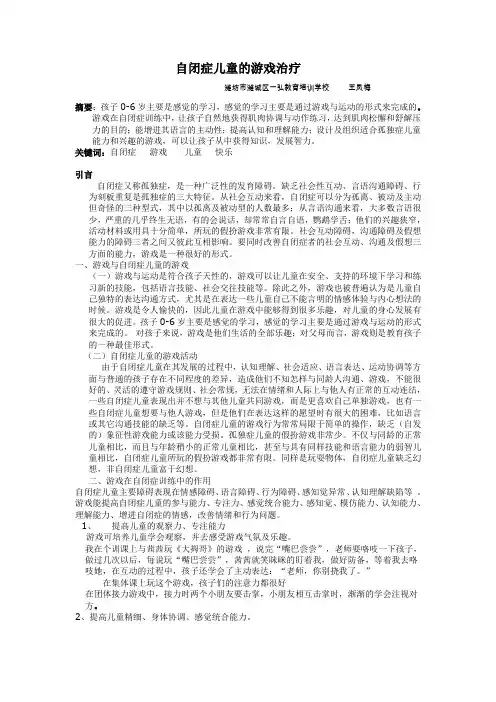
自闭症儿童的游戏治疗潍坊市潍城区一弘教育培训学校王凤梅摘要:孩子0-6岁主要是感觉的学习,感觉的学习主要是通过游戏与运动的形式来完成的。
游戏在自闭症训练中,让孩子自然地获得肌肉协调与动作练习,达到肌肉松懈和舒解压力的目的;能增进其语言的主动性;提高认知和理解能力;设计及组织适合孤独症儿童能力和兴趣的游戏,可以让孩子从中获得知识,发展智力。
关键词:自闭症游戏儿童快乐引言自闭症又称孤独症,是一种广泛性的发育障碍。
缺乏社会性互动、言语沟通障碍、行为刻板重复是孤独症的三大特征。
从社会互动来看,自闭症可以分为孤离、被动及主动但奇怪的三种型式,其中以孤离及被动型的人数最多;从言语沟通来看,大多数言语很少,严重的几乎终生无语,有的会说话,却常常自言自语,鹦鹉学舌;他们的兴趣狭窄,活动材料或用具十分简单,所玩的假扮游戏非常有限。
社会互动障碍,沟通障碍及假想能力的障碍三者之间又彼此互相影响。
要同时改善自闭症者的社会互动、沟通及假想三方面的能力,游戏是一种很好的形式。
一、游戏与自闭症儿童的游戏(一)游戏与运动是符合孩子天性的,游戏可以让儿童在安全、支持的环境下学习和练习新的技能,包括语言技能、社会交往技能等。
除此之外,游戏也被普遍认为是儿童自己独特的表达沟通方式,尤其是在表达一些儿童自己不能言明的情感体验与内心想法的时候。
游戏是令人愉快的,因此儿童在游戏中能够得到很多乐趣,对儿童的身心发展有很大的促进。
孩子0-6岁主要是感觉的学习,感觉的学习主要是通过游戏与运动的形式来完成的。
对孩子来说,游戏是他们生活的全部乐趣;对父母而言,游戏则是教育孩子的一种最佳形式。
(二)自闭症儿童的游戏活动由于自闭症儿童在其发展的过程中,认知理解、社会适应、语言表达、运动协调等方面与普通的孩子存在不同程度的差异,造成他们不知怎样与同龄人沟通、游戏,不能很好的、灵活的遵守游戏规则、社会常规,无法在情绪和人际上与他人有正常的互动连结,一些自闭症儿童表现出并不想与其他儿童共同游戏,而是更喜欢自己单独游戏,也有一些自闭症儿童想要与他人游戏,但是他们在表达这样的愿望时有很大的困难,比如语言或其它沟通技能的缺乏等。
10个自闭症孩子亲子小游戏,协助儿童与治疗者建立良好的互动关系自闭症谱系障碍是一种主要表现为社会交往和沟通能力有重大缺陷的精神发育障碍。
近十年来,ASD儿童数量明显上升,教育服务需求迫切而巨大。
据美国疾病控制中心2012年发布的发病率(1/88)推算,我国0—14岁ASD儿童人数可能多达250万。
这一群体家庭处境艰难,社会保障和支持体系面临一系列压力。
我国幼儿园和学校的专门化教育服务能力不足,软件条件短缺,传统的学校难以应对ASD儿童的特殊需求。
况且现有特殊学校缺少自闭症领域的专门人才和必要支持,而民间的一些康复训练机构水平参差不齐,干预缺少连贯性和理论的统整性,短期内难以出现针对性的医学治疗手段。
因此,我们需要积极探索ASD儿童教育服务的途径和方法,提供一种清晰而可行的总体思路。
在课程和活动中实现功能整合ASD儿童除了交往和沟通缺陷,有些还具有情感监控和意识调节方面的缺陷,但他们大致保留了完整的感知和运动机能,还有一些突出的特点,如注意力异常专注、机械重复式记忆、照相式的视觉加工,而这些都是教育干预的资源和依据。
为促进ASD儿童的功能整合,在教育活动中,教师和家长应注意以下几点。
第一,身心作用,整合一体。
教育活动必须动手、动脑、动心、动口(沟通),整合的教育要注重体验学习和基于工作的学习,把情感、活动、合作和交流融汇为一体,贯穿于始终,落实在当下。
注重日常生活中的功能化学习,开发生态化的活动课程,是全人教育的必然要求。
第二,人际关系(亲子关系、师生关系、心理治疗的关系)是教育的核心环节。
要注重优质教师能力的养成,营造宽松的文化氛围,促进融合的社会生活支持。
教育和抚育者的接纳、理解、陪伴、支持和引领作用,是最重要的教育资源。
第三,创造条件,设立平台,实现游戏、学习、职业训练的贯通,让ASD儿童最终有机会、有能力在就业、休闲、亲密关系和家庭生活等领域融入社会,体验生活意义。
第四,实施环境评估和能力评估,根据个体优势和特长实施因材施教的扬长(而非补短)的个别化教育方案。
10个自闭症孩子亲子小游戏,协助儿童与治疗者建立良好的互动关系在帮助自闭症儿童发展的过程中,亲子游戏是一个非常有效的方法。
通过亲子游戏,父母可以积极参与孩子的治疗,促进与孩子之间的良好互动关系。
以下是10个适用于自闭症儿童的亲子小游戏,可以帮助他们与治疗者建立良好的互动关系。
游戏一:抓捕彩色气球这个游戏可以帮助自闭症儿童提高注意力和精细动作能力。
将一些彩色气球充满气体,并抛到儿童的周围。
要求孩子尽可能多地抓住气球,可以通过这种方式引起他们的兴趣,增强他们与包围他们的其他人的互动。
游戏二:拼图比赛将拼图分为几份,父母和孩子各自选一份开始拼图。
通过竞争,促使孩子更积极地参与游戏,并与父母以及治疗者建立互动关系。
还可以适时给予鼓励,增强孩子的自信心。
游戏三:画画时间为孩子准备一些简单的画纸和颜料,和他们一起画画。
可以根据孩子的兴趣,共同选择绘画主题,例如动物、家庭等。
通过画画活动,孩子可以展示自己的创造力,而父母则可以倾听和表达对孩子作品的赞赏。
游戏四:音乐会打开音乐,和孩子一起跳舞和唱歌。
音乐可以唤起自闭症儿童的情绪,并促进他们与父母和治疗者的互动。
要注意选择孩子喜欢的音乐,帮助他们展示自己的节奏感和舞蹈能力。
游戏五:角色扮演通过角色扮演,可以帮助孩子模仿和理解社交技巧。
父母可以扮演一些角色,例如医生、老师,与孩子进行对话和互动。
这种亲子游戏可以让孩子体验不同社交场景,提高他们的沟通能力和情绪表达能力。
游戏六:户外活动带着孩子一起进行户外活动,例如踢足球、散步、骑自行车等。
这些活动可以增加自闭症儿童的运动量,促进与父母和治疗者之间的互动。
在户外环境中,孩子可以接触到不同的事物,拓展他们的视野。
游戏七:烹饪时间父母可以和孩子一起准备简单的食物,例如造小面包、做水果沙拉等。
通过参与烹饪,孩子可以学习食材的不同,注意力和执行能力也会得到提高。
与此同时,父母可以提供指导和鼓励,增强互动关系。
游戏八:拍摄合影找一个有意义的场景或活动,与孩子一起合影。
练习自闭症儿童肢体调和才能93个游戏1.与他人玩接球游戏;(1-2)练习目标:社交才能/手臂的活动才能练习请求:家长与孤单症儿童对面而坐,家长把球递给儿童,勉励儿童把球同样递给家长.难度设置:A开端时家长可把球直接放入孩子手中;B家长把球伸向孩子,勉励他/她伸手来接球.C当孩子自动把球给家长时,家长应当说“感谢”.帮忙赐与:假如孩子没有接球.给球的自动性,请别的一位成人赐与身材指点,直到孩子开端有自动接.给球的意识,逐渐地撤消赐与的帮忙.2.能抓着滚动的球,并把它推归去;(1-2)练习目标:手臂的活动才能/手眼调和练习请求:家长与孩子面临面坐在桌子两头,家长把球推给孩子,勉励他伸手把球接住并推回给家长.难度设置:A开端时须要在一手臂的距离内进行推.接球,勉励孩子双手接球.推球则用右手从右往左推.B逐渐地把距离拉大,并勉励孩子用双手往外推球,用单手接球.帮忙赐与:开端时须要别的一位成人的身材协助,留意造就孩子在每一难度的自力操纵技能,然后逐渐撤消帮忙的程度.3.能2步1级上楼梯;(1-2)练习目标:练习均衡力.调和及自力行走才能.练习请求:孩子能踏出右脚上一级楼梯,然后把左脚踏在统一梯级.难度设置:A扶着扶手或家长的手踏楼梯;B独自踏楼梯;帮忙赐与:开端时,家长可站在上一级楼梯上,伸出双手协助孩子并同时赐与口头指令“上!”;假如孩子不合作,可把干果放在楼梯上,等孩子踏上后赐与嘉奖.留意开端时可在每一梯级放干果,逐渐地,只在几级楼梯或最后一级楼梯上才放.不管孩子若何哭闹,要保持让孩子合营才干赐与嘉奖物.4.能哈腰并用手触摸脚指6.头5-10次;(1-2)练习目标:促进身材的柔嫩度及体能.练习请求:在孩子的脚趾头上分离贴一贴纸,让儿童哈腰揭下.难度设置:A开端时先让孩子把脚放在矮凳或最后一级楼梯上测验测验并且只揭1-2张贴纸即可;B孩子控制技能后可请求一次性揭掉落5或10张贴纸.帮忙赐与:家长须要在孩子旁边或死后协助,用双手轻压孩子的双膝,如孩子无法同时哈腰及伸直膝盖,可让他扶着桌子的边沿进行测验测验.5.会走上.下竖直约15度的小斜坡;(1-2)练习目标:重心.均衡.膝盖及小腿肌肉的控制才能.练习请求及帮忙赐与:上斜坡:开端时家长先站在斜坡上孩子跟前,拉着孩子的双手协助;孩子的技能纯熟后可站在其死后,只在他有须要的时刻推或搀扶孩子进步.下斜坡:开端时家长站在孩子死后,双手从孩子双肩上往下放在孩子胸前,勉励他扶着你的手下斜坡;孩子的技能纯熟后测验测验在他双手放置两件小玩具,让他在不必搀扶的情形下下斜坡.难度设置:A走上斜坡;B双手拿物走上斜坡;C搀扶下下斜坡;D独自下斜坡. 6.能倒走3-5步;(1-2)练习目标:空间概念,调和身材调和才能.练习请求:孩子能沿着一条直线倒退着走路.难度设置:A开端时只请求孩子随便在地板上倒走, B孩子熟习初步的请求后请求他在搀扶下沿直线倒着走;C请求孩子自力地沿直线倒着走.帮忙赐与:1 假如孩子开端时不体会,须要赐与身材指点,如:一人在前面扶着他的双手,别的一人在他死后轮流抬起他的阁下脚往后移.2 偶然地赐与身材协助.7.擦背游戏;(1-2)练习目标:加强肌肤的接触刺激.练习请求:给孩子洗澡时,用海绵或毛巾轻擦孩子的背部,从上到下.从左到右,按次序擦,也可打圈式地擦.难度设置:——帮忙赐与:——8.呵痒痒;(1-2)练习目标:加强肌肤的接触刺激.练习请求:家长用手挠孩子的头颈.胳肢窝.脚底等皮肤触觉迟钝处,手的力度一阵轻一阵重,假如孩子畏惧,或抗拒,先对其全身肌肤轻轻地抚摩,等孩子习惯今后再逐渐地把时光延伸.难度设置:——帮忙赐与:——9.刷子脱敏;(1-2)练习目标:加强肌肤的接触刺激,削减触觉防御.练习请求:家长用刷子先刷孩子的手背.手指等触觉防御性较少的部位,然后逐渐过渡到刷孩子的手心.再刷脚的部位,先刷脚趾.脚跟.然后逐渐过渡到刷脚地中间部位.假如孩子抗拒,可每次只擦一下,反复地测验测验,直至孩子习惯这种触觉刺激.难度设置:——帮忙赐与:——10.阳光地道;(1-2)练习目标:调节前庭感到体系,加强肌肤的接触刺激.练习请求:让孩子俯卧着身材,从地道中爬行经由过程.难度设置:A假如孩子畏惧,先让其在地道周围玩耍并不雅察其他孩子若何做,让孩子触摸和摇摆地道,造就其兴致和清除恐怖感;B 假如孩子不合作,可以赐与食物强化,爸孩子爱好吃的零食或生果放在地道里,勉励孩子爬进去拿取食物;C 让孩子边爬边推一个中型球进步.帮忙赐与:全程由家长身材指点完成.假如孩子消失重要或抗拒的情形,请以勉励.引诱方法取得其合营为主,不要强制合营,以免造成孩子肌肉过度重要,后果拔苗助长.应用食物强化事要留意逐渐裁撤.11.能推“趣怪球”至1米外的指14.定地方;(2-3)练习目标:成长社交才能及手眼调和才能(目测物体的速度的才能.反响才能),成长大活动——手部肘关节和手臂的活动才能.练习请求:孩子和家长分离站在1米的距离内,互相推.接“趣怪球”.须要时要有另一成人协助孩子的动作.难度设置:A 在必定规模内接球;B 服从口头指令去把球捡回指定地点.帮忙赐与:尽量让孩子在必定规模内本身接球,须要时赐与口头提示或身材指点.假如孩子对指令没有反响,须要加以身材指点及白话提.手势提示.12.能在协助下对墙推球和接球;(2-3)练习目标:手臂的活动才能/手眼调和练习请求:让孩子双手抱着中型球,顿在地上用双手把球往墙角推.难度设置:A开端时离墙的距离要在一步以内;B逐渐拉大离墙的距离,并请求孩子借助墙壁的反弹力接住弹回来的球.帮忙赐与:手把手的身材协助;慢慢撤消.13.能推着物体向前走2-3米;(2-3)练习目标:成长大活动——手臂推的才能;因果关系的概念;手.眼和腿的动作调和才能.练习请求:把会发声的“鸭子杆”或相似的玩具放在孩子的手里,让他向前履行.难度设置:A 绕大圆桌子; B绕2张距离1米阁下的凳子; C绕3-5张不合距离的凳子(留意凳子摆放的距离要足够孩子和“鸭子杆”经由过程).帮忙赐与:身材指点(即手把手地教)其实不竭地用口头提示和身材接触来提示孩子看前面的玩具的活动轨迹,给孩子模拟玩具发出的声音;转弯时告知孩子正在转弯并用手改正.帮忙他转弯的偏向.14.拉物走2-3米;(2-3)项目请求:在一会发声玩具车上系一合同50公分长的绳索,在绳索上缠一个骗局在孩子的手段上,让孩子拉着往前走.难度设置:A 绕大圆桌子; B绕2张距离1米阁下的凳子; C绕3-5张不合距离的凳子(留意凳子摆放的距离要足够孩子和车子经由过程).帮忙的赐与:A 手把手,其实不竭用说话提示看死后的车子的活动轨迹及前方要走的偏向; 15.单手投中型球;(2-3)练习目标:手眼调和才能.练习请求:让孩子站在必定的距离外把球单手投入球篮中.难度设置:A只在半步的距离外测验测验;B在1米阁下的距离外把球投入球篮;C投5次有3次中为经由过程.帮忙赐与:1 开端时赐与足够的身材协助并勉励孩子自力测验测验;2 只在孩子犯规时赐与口头提示.16.能把静止的球踢向前方1米远的距离;(2-3)练习目标:成长大活动——腿的伸展才能,成长眼.腿的调和才能;练习请求:把一向径10公分阁下的软球放置在孩子跟前,让孩子踢球.难度设置:A 踢向前方1米远的距离;B 踢向前方1米远距离的物体.帮忙赐与:A 口头提示+身材指点+说话提示;B 身材指点;C 偶然的身材指点+说话提示.17.单手扶栏上.下楼梯,21.两步一级;(2-3)练习目标:练习请求:难度设置:帮忙赐与:18.能哈腰阁下腿瓜代钻过呼啦圈;(2-3)练习目标:肢体活动及均衡才能的控制.练习请求:给孩子一个大号的呼啦圈,示范给他/她看若何双手分离握着呼啦圈双方并把它放在正前方的地位.弯下腰,然后把一只脚跨入呼啦圈,接着跨入别的一只脚.难度设置:A 开端时把呼啦圈放低一点,并且帮忙孩子握着呼啦圈;B 高度稍微调高,请求孩子本身拿呼啦圈,须要时赐与帮忙;C 请求孩子双脚跨入后迁移转变双手把呼啦圈由后往前翻转到跨入前的地位(在身材的正前方).帮忙赐与:1 假如孩子谢绝游戏,可以多做几回演习,并且邀请孩子一同介入游戏;2 留意确保孩子的安然,在每一须要的环节赐与恰当的身材和口头帮忙. 3 实时勉励和表扬孩子.19.能哈腰阁下腿瓜代钻过呼啦圈;(2-3)练习目标:肢体活动及均衡才能的控制.练习请求:给孩子一个大号的呼啦圈,示范给他/她看若何双手分离握着呼啦圈双方并把它放在正前方的地位.弯下腰,然后把一只脚跨入呼啦圈,接着跨入别的一只脚.难度设置:A 开端时把呼啦圈放低一点,并且帮忙孩子握着呼啦圈;B 高度稍微调高,请求孩子本身拿呼啦圈,须要时赐与帮忙;C 请求孩子双脚跨入后迁移转变双手把呼啦圈由后往前翻转到跨入前的地位(在身材的正前方).帮忙赐与:1 假如孩子谢绝游戏,可以多做几回演习,并且邀请孩子一同介入游戏;2 留意确保孩子的安然,在每一须要的环节赐与恰当的身材和口头帮忙. 3 实时勉励和表扬孩子.20.坐在童车上被推,24.能保持双脚在脚塔上(2-3);练习目标:成长大活动——腿的控制才能.双腿活动时的调和才能.双腿肌肉的控制才能.练习请求:把孩子放置在童车上(童车的选摘要以孩子坐下后,臀部.膝盖及脚踏三点的角度约为45度的车子为宜),家长在后面推进车子.帮助用品:改进的魔术带.难度设置:——帮忙赐与:1身材指点并控制好车头转弯的地位;2 尽量让孩子本身测验测验. 21.会走S型的线段;(2-3)练习目标:空间概念,肢体的均衡才能.练习请求:在地上用不粘胶粘出一条S型线段,让孩子从一端走到别的一端.难度设置:——帮忙赐与:1 开端时可站在孩子的前面拉着他/她的双手引诱他/她往前走;2 也可以站在孩子的后边,让他/她推着一个手推玩具沿着线段向前走;3 勉励孩子本身往前走,并在别的一端放一个玩具或小食物来嘉奖孩子的成功测验测验.假如孩子因为见到嘉奖物而不合营练习,则可以等孩子完成了路线后拿出神秘嘉奖物嘉奖给他/她.22.坐上大龙球练习目标:改良身材调和不良,加强重力感的控制才能,树立和刺激前庭机能对多动和身材调和不佳的孩子有较大的帮忙.练习请求:协助孩子坐在大龙球上,指点者可以撒手,只要协助保持大龙球的稳固即可,勉励孩子用屁股力气作高低跃动.孩子要作前后.阁下摇摆时,指点者可以用手握住孩子双手,以协助孩子保持身材的均衡.23.治疗球—坐姿动作;(2-3)练习目标:均衡调剂力.呵护反响.肌力.调和.速度等.练习请求:让孩子坐于治疗球上双脚离开天然垂下,双手扶于球上或腿上, (1)保持放松做动作(毫不成在肌肉僵直状况下操纵). (2)控制─力气.速度.角度.和搀扶的大小.难度设置: (1)移动治疗球;(2)弹出发体并移动治疗球;(3)自动移动或弹动;(4)均衡及呵护反响之诱发;(5)用两手交互拍球;(6)用两脚的脚跟交互踢球.帮忙赐与:全程由家长身材指点完成.假如孩子消失重要或抗拒的情形,请以勉励.引诱方法取得其合营为主,不要强制合营,以免造成孩子肌肉过度重要,后果拔苗助长.24.跳起并接触吊挂着的物件10次;(2-3)练习目标:腿部.膝盖活动才能及身材调和才能.练习请求:在空中孩子跳跃时可及的地方吊挂一个玩具(气球或会弹跳的玩具),勉励孩子跳跃并伸手触摸该玩具.难度设置:A 吊挂物开端时挂得稍低一点,让孩子轻易触到;B 孩子控制了这一技能后,把吊挂物稍微挂高,勉励孩子应用自身的力气弹跳起来.帮忙赐与:1 假如孩子不理解控制身材的力气,可先用双手扶着他/她的腋下,帮忙他/她演习弹跳;2 经由过程跳弹床和在床垫上跳跃来控制弹跳;3 赐与勉励和嘉奖来促进孩子演习的兴致.25.扔球3米远;(3-4)练习目标:手臂活动才能/手眼调和才能.练习请求:把一个小型球或豆球扔到3米远的地方.难度设置:——帮忙赐与:1 开端时假如孩子不体会扔球的动作,可手把手地教;2 给孩子在前方画一条线来提示他/她要扔的距离;3 为勉励孩子测验测验,可在线的旁边放一玩具或小食物来作为嘉奖物.26.把豆袋或相似的玩具扔进1米距离阁下远的大盒子中;(2-3)练习目标:手臂活动才能/手眼调和才能,进修向着目标抛掷物件.练习请求:能持续5此把豆袋或相似的玩具扔进1米距离外的大盒子中.难度设置:A开端时把距离设短一点,如只请求儿童站在距离大盒子一步或两步的距离;B逐渐地把距离拉大;C逐渐地把大盒子换成小一点的盒子.帮忙赐与:A手把手地帮忙孩子扔掷;B 只是在孩子姿态错误时才赐与帮忙. 27.互动式投篮:(3-4)练习目标:手臂活动才能/手眼调和才能,促进与人互动的才能.练习请求:家长及孩子轮流投篮;家长投完后把球捡起来给孩子投.难度设置:——帮忙赐与:——28.一步1级上.下楼梯;(3-4)练习目标:促进孩子的均衡才能.练习请求:孩子能一步跨上一个阶梯,持续上或下楼梯.难度设置:A 成人站在孩子前面或后面,伸出双臂或双手的拇指,让孩子抓住拉孩子上楼梯;B 成人将左手手臂或拇指举高,右手手臂或拇指则在孩子右侧腰间的地位,让孩子在搀扶下本身均衡用力高低楼梯;C 成人伸出左手手臂或拇指搀扶孩子上.下楼梯;D 让孩子独自上.下楼梯.帮忙赐与:A 双手(或拇指)举高赐与协助;B 一手(拇指)高,一手(拇指)低赐与协助;C 单手(拇指)赐与协助;D 裁撤所有协助.29.双脚轮流跨过15厘米高的绳;(3-4)练习目标:身材均衡才能.练习请求:绳索的两头分离固定在柱子或椅子上离地15CM高,让孩子双脚轮流举高跨过绳索.难度设置:——帮忙赐与:1 用姿态示意孩子若何抬腿跨过绳索,须要时赐与身材协助,伸手把他/她的腿举高跨绳;2 要不时口头提示孩子留意脚下的绳索,防止绊倒;3 建议用有弹性的圆形橡皮绳.30.本身上.下小三轮车;(3-4)练习目标:难度设置:帮忙赐与:31.双脚原地跳;(3-4)练习目标:练习请求:难度设置:帮忙赐与:32.双脚一齐从最后一级楼梯跳下;(3-4)练习目标:练习请求:难度设置:帮忙赐与:33.扶物能单脚站立5秒;(3-4)练习目标:均衡才能.练习请求:孩子能扶着椅子或家长手握的棒子单脚站立约5秒.难度设置及帮忙赐与:A 手把手地教孩子用双手扶着椅子的*背,提起孩子的一条腿悬空约5秒,然后放下.进程顶用简略的说话告知孩子怎么做,如:“抬腿!”.“放下!”B 让孩子本身测验测验5秒内(可用数数提示他/她)不要把脚放下;C 孩子控制了技能后,改用棒子.家长双手握住棒的两头,孩子则抓住中央反复以上步调.34.踏小三轮车转弯避开障碍物;(3-4)练习目标:难度设置:帮忙赐与:35.能跳过5厘米高的绳;(3-4)练习目标:练习请求:难度设置:帮忙赐与:36.在10厘米宽2米长的地面线条上走保持身材均衡;(3-4)练习目标:均衡才能的控制.练习请求:在地板上用不粘胶粘一条2米长10厘米宽的线条让孩子在线条上走.难度设置:A 开端时只走一半的距离,许可偶然走出界外;B 请求孩子走完整程,尽量不要走出界外.帮忙赐与:1 练习者可站在孩子前方,拉着孩子的手向前走;2 要提示孩子既留意脚下的线条,又要留意前方的路;3 练习者在孩子的前方引诱孩子走,但不赐与身材协助;3 让孩子本身测验测验独自走.37.单脚原地跳;(3-4)练习目标:练习请求:难度设置:帮忙赐与:38.能学青蛙跳20厘米的距离10次;(3-4)练习目标:腿部活动才能/重心及均衡才能.练习请求:用不粘胶在地板贴两条均衡线,成人给孩子示范若何做青蛙跳几回,然后指点孩子模拟.难度设置:A 开端时,线段间的距离应当短一点,让孩子轻易达标;B 假如孩子不肯意合作,可引入食物嘉奖的办法,把嘉奖物放在落地的一端之线条上,孩子跳到线上就嘉奖;C 逐渐地把线段间的距离增大.帮忙赐与:1 身材协助;2 每一难度中假如孩子碰到问题,都要实时赐与身材或口头上的指点,反复示范并留意提起孩子介入的兴致.39.做连续串手部和腿部动作时能保持均衡;(3-4)练习目标:身材的控制和调和才能.练习请求:让孩子模拟一系列的手部和腿部动作,如:跳舞.打工夫等.难度设置:A 选择简略一点的动作;B 选择较为庞杂的动作,包含弹跳.跳跃等动作.帮忙赐与:1 别的一成人站在孩子旁边,假如孩子掉去均衡,只在他/她可能要摔倒时才赐与搀扶;2 在孩子前后方均铺上垫子,孩子摔倒后勉励他/她本身起来持续演习.40.能阁下腿瓜代倒着钻过呼啦圈;(3-4)练习目标:双脚的调和才能及身材均衡才能.练习请求:练习者拿着呼啦圈站在孩子的死后,勉励孩子阁下腿瓜代着向后移入呼啦圈内.难度设置:A 由别的一成人搀扶着孩子完成动作,并且呼啦圈的高度要调低一点;B 逐渐地呼啦圈的高度进步;C 由孩子本身测验测验着完成动作,只在有须要时赐与帮忙.帮忙赐与:1 足够的身材协助;2 须要的身材协助;3 偶然的身材协助.41.能往返滚出发体;(4-5)练习目标:迷路反射控制,身材的控制才能及调和才能.练习请求:让孩子在垫子上或在床垫上从一端翻腾到别的一端.难度设置:A 在练习者的身材协助下进行翻腾;B 本身控制身材进行翻腾.帮忙赐与:1 赐与大量的身材协助和口头提示,让孩子从练习中理解若何控制本身的身材及翻动的速度和力气;2 只在有须要时赐与身材协助;3 确保孩子的安然,防止碰伤.42.转椅游戏;(3-4)练习目标:调节中间与均衡力.练习请求:让孩子坐在转椅内,家长在一旁扭转椅子,速度逐渐加快.难度设置:A开端时为防止孩子重要,可让其双手抓住椅子的扶手;B孩子习惯后请求其两手天然放在腿上*身材控制重心,并闭上眼睛.假如孩子不合营,可用布带将其双眼蒙住.帮忙赐与:43.做5次前滚翻;(4-5)练习目标:促进调和.均衡才能,刺激本体感到.练习请求:让孩子模拟成人持续做5次前滚翻的动作.难度设置:A 开端时只请求做2-3次;B 请求孩子持续做5次,并请求孩子在动作进程中身材尽量保持直线.帮忙赐与:1 开端时要全程赐与身材协助,并用说话勉励孩子测验测验;2 尽量让孩子本身完成,须要时赐与口头提示,要随时留意孩子的安然问题.44.能用勺子把乒乓球送至约2米外的目标地而乒乓球不掉落下来;(4-5)练习目标:促进均衡才能和手部控制才能,加强动作企画才能.练习请求:用勺子把乒乓球送到2米外的地方.难度设置:A 开端时测验测验先给孩子一个立方体的积木在距离极短的两张桌子间传送,让孩子便于操纵;B 用不粘胶在地上贴两条均衡线;C 改用乒乓球测验测验;D 按照预设距离练习.帮忙赐与:1 为进步孩子的兴致,建议开端时成人和孩子一路介入游戏;2 孩子的技能闇练后,勉励孩子和其他孩子进行比赛.45.能走完1个有5项步调的障碍路径;(4-5)练习目标:加强身材控制及均衡才能,促进动作企画才能.练习请求:孩子能独自走完一个有5项步调的障碍路径.难度设置:A 开端时只设置2-3个障碍物(跨过玩具.绕过椅子.爬过桌子).B 设置5个障碍物,引入嘉奖物.帮忙赐与:1 开端时成人先做示范,然后陪伴孩子一路进行练习,要有实时.足够的身材和口头提示;2 勉励孩子本身做,并赐与恰当的提示;3 勉励孩子与其他孩子以比赛的情势进行练习.46.能用脚尖站立10次,每次站立3秒钟;(4-5)练习目标:腿部活动才能.重心及均衡才能.练习请求:让孩子双脚脚跟着地,脚尖掂起地站立,每次站立3秒钟时光.难度设置:A 开端时让孩子扶着墙壁或椅背站立;B 让孩子测验测验徒手站立.帮忙赐与: 1 可以在墙壁上孩子掂脚可触及的地方挂一嘉奖物,勉励孩子掂起脚去拿取;2 给孩子数数,让他/她知道要站多长时光.47.能在20厘米宽,10厘米高的均衡木上行走而保持均衡;(3-4)练习目标:促进孩子的均衡才能.练习请求:让孩子在不搀扶,保持身材均衡的情形下走,走过划定尺寸的均衡木.难度设置:A 只走一半的距离;B 走完整程;C 单手持物走;D 双手持物走.帮忙赐与:1 开端时成人须要反复做示范,并跟在孩子后边走,赐与身材协助,如拉着孩子双手或扶其双肩;2 成人站在均衡木一旁,孩子行走时拉着他/她的一只手赐与搀扶;3 只在须要时赐与搀扶.48.能持续拍球3次而球不弹走;(4-5)练习目标:加强手臂的控制才能,成长手眼调和才能.练习请求:孩子能持续拍3次中型球(篮球大小的球).难度设置:A 只拍1次;B 拍2-3次;帮忙赐与:1练习者拍一下,等球弹起后把着孩子的手拍一下;2 把着孩子的手教孩子拍2-3下,球要尽量弹高,便于孩子的手有足够的时光调节49.双脚被提起时,可用双手向前走路;(4-5)练习目标:加强手臂力气和调和才能.练习请求:让儿童趴在地上,双手和双膝接触地面,成人则在儿童死后握其双足足踝,示意儿童用双手瓜代活动往前爬.难度设置:A 先让儿童习惯被提起双脚的姿态;B 勉励儿童向前走1-2步;C 练习至儿童能自如地向前走.帮忙赐与:1 以游戏的情势帮忙孩子习惯被短暂提起双脚的姿态和感到;2 延伸提起孩子双脚的时光;3 勉励孩子测验测验向前走,用食物或其他孩子爱好的办法来强化.50.跑向滚动着的球,把球向前踢;(4-5)练习目标:动作企画才能.偏向感.练习请求:让孩子边跑边踢滚到他/她脚下的中型或小型球.。
幼儿自闭症治疗中的游戏疗法自闭症是一种儿童神经发育障碍,表现为社交互动和沟通能力的缺陷,以及刻板重复的行为和兴趣。
幼儿自闭症的治疗需要综合多种方法,其中游戏疗法是一种被广泛应用的治疗手段。
本文将探讨幼儿自闭症治疗中的游戏疗法的重要性和有效性。
一、游戏疗法的定义和原理游戏疗法是一种通过游戏活动来促进幼儿自闭症患者社交互动和沟通能力的治疗方法。
游戏疗法的原理是通过创造有趣的游戏环境,吸引幼儿的注意力,激发他们的兴趣和参与度,从而提高他们的社交能力和沟通能力。
二、游戏疗法的种类1. 角色扮演游戏:通过模仿和扮演不同的角色,幼儿可以学习社交技巧和情绪表达。
例如,扮演医生和患者的角色,可以帮助幼儿理解和表达自己的感受。
2. 社交互动游戏:通过与其他幼儿进行互动,幼儿可以学习合作、分享和交流。
例如,玩捉迷藏游戏可以帮助幼儿学会与他人合作和沟通。
3. 感官游戏:通过触觉、听觉、视觉等感官刺激,幼儿可以提高感知能力和注意力。
例如,玩泡泡游戏可以帮助幼儿集中注意力和追踪移动物体。
4. 创造性游戏:通过绘画、手工制作等创造性活动,幼儿可以培养想象力和创造力。
例如,让幼儿画一幅自己喜欢的动物,可以帮助他们表达自己的兴趣和想法。
三、游戏疗法的优势1. 提高参与度:游戏疗法可以创造有趣的游戏环境,吸引幼儿的注意力,提高他们的参与度和积极性。
2. 增强社交能力:通过与其他幼儿进行互动,幼儿可以学习社交技巧和情绪表达,提高他们的社交能力。
3. 促进沟通能力:游戏疗法可以提供各种沟通的机会,例如通过角色扮演和互动游戏,幼儿可以学习表达自己的想法和感受。
4. 培养想象力和创造力:创造性游戏可以帮助幼儿培养想象力和创造力,提高他们的认知能力和问题解决能力。
四、游戏疗法的实施步骤1. 评估幼儿的能力和需求:在实施游戏疗法之前,需要对幼儿的社交互动和沟通能力进行评估,了解他们的能力和需求。
2. 设计游戏活动:根据幼儿的能力和需求,设计适合他们的游戏活动,包括角色扮演、社交互动、感官刺激和创造性活动等。
·小魔术·齐心协力(张燕)两个人背靠背两手臂相挽夹着装有半瓶水的瓶子横着前进,一个人(就是当木桩子)站在对面,两人靠背部力量绕过那个人,不能掉,掉了从来,回来以后立刻给下一组队友,计时看用时长短,用时最短的胜利!·终极进化(张燕)分为鸡蛋,鸡,凤凰,人四个等级。
随机在人群里找人剪刀石头布,赢了进一个等级,输了退一个等级,一直输就一直是鸡蛋!(鸡蛋蹲着有鸭子步,鸡半蹲着飞,凤凰站着挥动手臂,人直立,要保持自己的动作),规定时间到了以后找到各自队伍,沦为鸡蛋的受惩罚!(当时做这个游戏的时候老师是想教会我们诚实做人)·心有灵犀(张燕)大家坐在地上,从后往前依次在前一位背上传递信息,最前面一位报出所获得的数字信息,暗号规定各组自己商定!·疯狂猜词(计邹慧)你来表演我来猜,五个人一组,两个人猜三个人合作表演。
或者可以七八个人一组,排成一列,第一个人看词思考表演给下一个人,下一个人根据自己理解再表演给下一个,到最后一个人说出词语·(何智辉)同学们右手向上伸出拇指,左手向下伸出手掌顶住另一同学的拇指。
主持人开始说话,规定好说到某个字时,同学的右手要迅速向下躲开别人的手,同时左手努力抓住另一同学的拇指。
·萝卜蹲(孙艺恒)将一个班分为六七个小组,每组人数一样多。
每组手拉手站到一起,并且给自己的小组起名字,如“苹果”“萝卜”“橘子”等。
主持人起头说“萝卜蹲”,名叫“萝卜”的小组所有成员一边蹲起一边说“萝卜蹲,萝卜蹲,萝卜蹲完xx蹲”。
被点到的小组需要马上一边蹲一边说xx蹲xx蹲xx蹲完yy蹲。
yy组继续。
每个小组都不能再点前一次蹲过的小组。
反应慢或者点名不齐的小组全组接受惩罚,可以是十个小兔蹦。
例如:主持人:“萝卜蹲!”萝卜组:“萝卜蹲,萝卜蹲,萝卜蹲完苹果蹲!”苹果组:“苹果蹲,苹果蹲,苹果蹲完橘子蹲!”(此时苹果组不能点名萝卜组)接下来橘子组继续。
快乐游戏幼儿自闭症治疗中的治疗游戏设计自闭症是一种儿童神经发育障碍,常常表现为社交交往困难、语言沟通障碍和刻板重复行为。
幼儿自闭症的治疗过程中,游戏被广泛应用于帮助儿童建立社交技能、提高语言表达能力和培养创造力。
本文将介绍几种适用于幼儿自闭症治疗的快乐游戏设计。
一、角色扮演游戏角色扮演游戏是一种能够帮助幼儿自闭症患者提高社交技能的治疗方法。
在游戏中,治疗师可以扮演不同的角色,例如医生、老师、爸爸妈妈等,引导幼儿自闭症患者与其进行互动。
通过模拟真实生活场景,幼儿可以学习如何与他人进行交流、表达自己的需求和理解他人的情感。
此外,角色扮演游戏还可以培养幼儿的想象力和创造力,提高他们的语言表达能力。
二、拼图游戏拼图游戏是一种能够帮助幼儿自闭症患者提高注意力和问题解决能力的治疗方法。
在游戏中,治疗师可以选择适合幼儿年龄和能力水平的拼图,引导幼儿自闭症患者进行拼图。
通过拼图游戏,幼儿可以锻炼手眼协调能力,提高注意力和集中力,并培养解决问题的能力。
此外,拼图游戏还可以帮助幼儿自闭症患者学习如何与他人合作,共同完成任务。
三、音乐游戏音乐游戏是一种能够帮助幼儿自闭症患者提高语言表达能力和情绪管理能力的治疗方法。
在游戏中,治疗师可以选择适合幼儿年龄和能力水平的音乐游戏,例如唱歌、跳舞、敲打乐器等。
通过参与音乐游戏,幼儿可以学习如何用声音表达自己的情感和需求,提高语言表达能力。
此外,音乐游戏还可以帮助幼儿自闭症患者学习如何控制情绪,培养情绪管理能力。
四、益智游戏益智游戏是一种能够帮助幼儿自闭症患者提高认知能力和问题解决能力的治疗方法。
在游戏中,治疗师可以选择适合幼儿年龄和能力水平的益智游戏,例如拼字游戏、数学游戏、迷宫游戏等。
通过参与益智游戏,幼儿可以锻炼思维能力,提高注意力和集中力,并培养解决问题的能力。
此外,益智游戏还可以帮助幼儿自闭症患者学习如何与他人合作,共同解决问题。
总结:快乐游戏在幼儿自闭症治疗中起到了重要的作用。